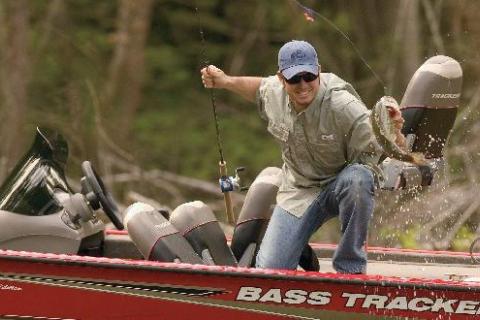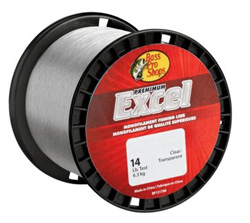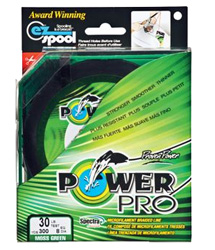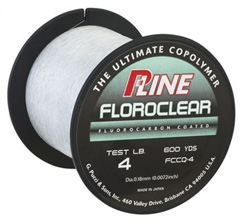
Fishing line is arguably the single most important equipment item for fishermen. It plays a key role in bait and lure presentation, in hooking fish and in landing the fish one hooks. Yet most anglers remain confused and uneducated about the types of line now available, and the special properties each exhibits. That's unfortunate, because understanding the pros and cons of different line types, and using that knowledge to employ the right lines in the right situations, can greatly improve one's fishing success. This article was written to help in that respect.
![]() Tip Watch Video: How Kevin VanDam knows the right line for the right fishing situation
Tip Watch Video: How Kevin VanDam knows the right line for the right fishing situation
Monofilament Fishing Line
 |
| After nearly 50 years, monofilament remains the most popular fishing line on the market. |
In 1938, DuPont announced the discovery of nylon, a "group of new synthetic superpolymers" that could be made into textile fibers stronger and more elastic than cotton, silk, wool or rayon. The next year, DuPont began commercial production of nylon monofilament fishing line. This new line, primitive by today's standards, didn't catch on immediately; older fishing lines, particularly braided Dacron, remained popular for the next two decades.
In 1958, however, DuPont introduced Stren, a thinner line of more uniform quality that could be used with different types of reels, including newly introduced spinning and spincasting tackle. This line was quickly embraced by fishermen and led to a boom in sportfishing popularity because it helped make fishing much easier.
Monofilament products remain popular. As the name suggests, this is a single-component product. It is formed through an extrusion process in which molten plastic is formed into a strand through a die. This process is relatively inexpensive, producing a less costly product — that being the main reason monos are so widely popular.
But it's important to remember that cheaper brands of monofilament usually don't receive the quality-control attention, additives and attention in the finishing process that premium-grade lines receive. As a result, they may not offer the superb blend of tensile strength, limpness, abrasion resistance, and knot strength characteristic of more expensive monos. In other words, you get what you pay for. Cheap off-brand monos usually don't perform as well as more expensive name brands, so "buyer beware." If you decide to use monofilament, test several name brands and stick with those you come to know and trust.
How Kevin VanDam knows the right line for the right fishing situation
Braided Fishing Line
 |
| Braided "superlines" are made of synthetic fibers and are more than 10 times stronger than steel. |
Before the discovery of nylon, braided line Dacron was the most popular line. Dacron possessed poor knot strength, low abrasion resistance and little stretch, however, so it was used much less after superior nylon monofilaments were introduced. Today, it maintains only a very small niche in the marketplace, being used primarily by some catfishermen, who believe its softness improves their catch rate; as backing material on fly reels; and, for a few anglers, as a big-game trolling product.
In the early 1990s, gel-spun and aramid fibers such as Spectra, Kevlar and Dyneema entered the fishing line market, creating a new category of braided lines often called "superlines" or "microfilaments." These synthetic fibers are thin and incredibly strong (more than 10 times stronger than steel). Individual fiber strands are joined through an intricate, time-consuming braiding process to produce ultrathin, superstrong, sensitive, yet expensive lines.
Anglers who experimented with early superlines were frustrated by low knot strength, backlashes, poor coloration, damaged equipment, impossible snags, and more. To many, these disadvantages outweighed the benefits of strength, microdiameter, and ultra sensitivity — particularly considering the exorbitant costs. However; makers of superlines have made continual advances and improvements to the raw material fibers and the process that converts them into fishing line. Coloration, castability, and strength have all been improved, overcoming some early disadvantages.
Lures dive deeper and faster when connected to superlines. And because it's smaller in diameter, superline is less visible to fish than monofilament, and anglers can spool more line on their reels. Superlines have little stretch, transmitting strikes instantly to the rod tip, thus providing more positive hook sets. Plus, superlines allow longer casts, making them ideal for shore-bound anglers. High break strength and low stretch permit better manhandling of big fish.
Saltwater anglers use most of the braided superlines. Sometimes, the line is used as a backing for mono, allowing anglers to use small reels while increasing line capacity. Many anglers prefer the softness of braid for vertical jigging and trolling.
Superlines require a palomar knot for best results. Put mono backing on your reel before spooling superlines to prevent "slipping" on the reel and to conserve line. This also adds firmness to the spool for better casting and less backlashes. Tie a Uni knot to connect to the mono.
Do not overfill reels with superline. Overfilling creates loose strands after a cast and more backlashes. Fill to one-eighth inch from the spool rim.
A more recent innovation is fused line, made by fusing, rather than braiding, the gel-spun fibers. This process produces what appears to be a single-strand line that is also ultrathin, superstrong, and very sensitive. These lines are larger in diameter and offer a bit less strength than original braids, but they are somewhat easier to cast and tie, and generally more affordable.
![]() Tip Watch Video: Quick Tips for Better Fishing Line Performance
Tip Watch Video: Quick Tips for Better Fishing Line Performance
Fluorocarbon Fishing Line
 |
| Fluorocarbon line offers advantages in clear-water situations and rough conditions. |
Fluorocarbon is a polymer that's nearly invisible in water because it has an almost identical refractive index (an indication of the degree at which light refracts or bends as it passes through a substance). It is inert, so it resists deterioration by sunlight, gasoline, battery acid or DEET (a common ingredient in insect repellents). And it doesn't absorb water.
Fluorocarbon fishing leaders originated in Japan, where anglers are particularly fussy about bait presentations. Japanese fisheries are heavy pressured, so lifelike bait presentations are important. Nearly invisible fluorocarbon lines enhanced this quality.
Ultimately, U.S. anglers began using fluorocarbon leaders, primarily in saltwater and fly fishing applications, for the same reason the Japanese were using it — low visibility. It caught on when anglers reported catching more fish with it. The original fluorocarbon leaders were stiff and very expensive, but new technologies have produced more flexible fluorocarbon at more affordable prices.
Fluorocarbon certainly offers advantages in clear-water situations where fish are heavily pressured or slow to bite. Also, because fluorocarbon does not absorb water, it won't weaken or increase in stretch like nylon fishing line. Added density makes fluorocarbon very abrasion-resistant, so it's ideal for rough conditions, and makes it sink faster than nylon lines, so lures dive deeper and faster. And because fluorocarbon stretches slower and less than nylon, particularly when compared to wet nylon, it's much more sensitive.
Fluorocarbon lines, like superlines, require special attention. The Trilene knot is the best to use with this type line. Make all 5 wraps when tying the knot, and excessively wet the line before cinching the knot to prevent line weakening. Always test the knot before fishing.
Fluorocarbons are still stiffer than nylon, even when wet. This requires more attentiveness to the line when casting, and finer "balance" of tackle. If heavier fluorocarbon line is used on lighter rods, reels and lures, anglers will experience more difficulty. Baitcasting reels may require additional adjustment for the extra momentum created by the heavier weight of fluorocarbon. Adjust mechanical brakes to the weight of the line and lure to maximize casting distance and minimize overruns.
![]() Tip Watch Video: Stone Cold Fishing "Best Lines for Ice Fishing"
Tip Watch Video: Stone Cold Fishing "Best Lines for Ice Fishing"
Final Verdict: Which Fishing Line?
No single type of line is perfect for all fishing conditions. To choose the best line, anglers should consider the size and species of fish being targeted, the type of water being fished, the type of tackle being used, and other factors. Then one must consider all the qualities needed in a good line for those situations, including proper breaking strength, diameter, abrasion resistance, stretch, flexibility, knot strength, visibility and durability. You might simply pull any spool of line off the tackle dealer's shelf and luck into one that will work right for you. But today more than ever, with the many types of lines available, it's important to devote time to studying each line and its characteristics so you will have the best for each fishing situation. By doing so, you'll improve your catch rate. And catching more fish, after all, is what we all hope to do.
- 183431 views

